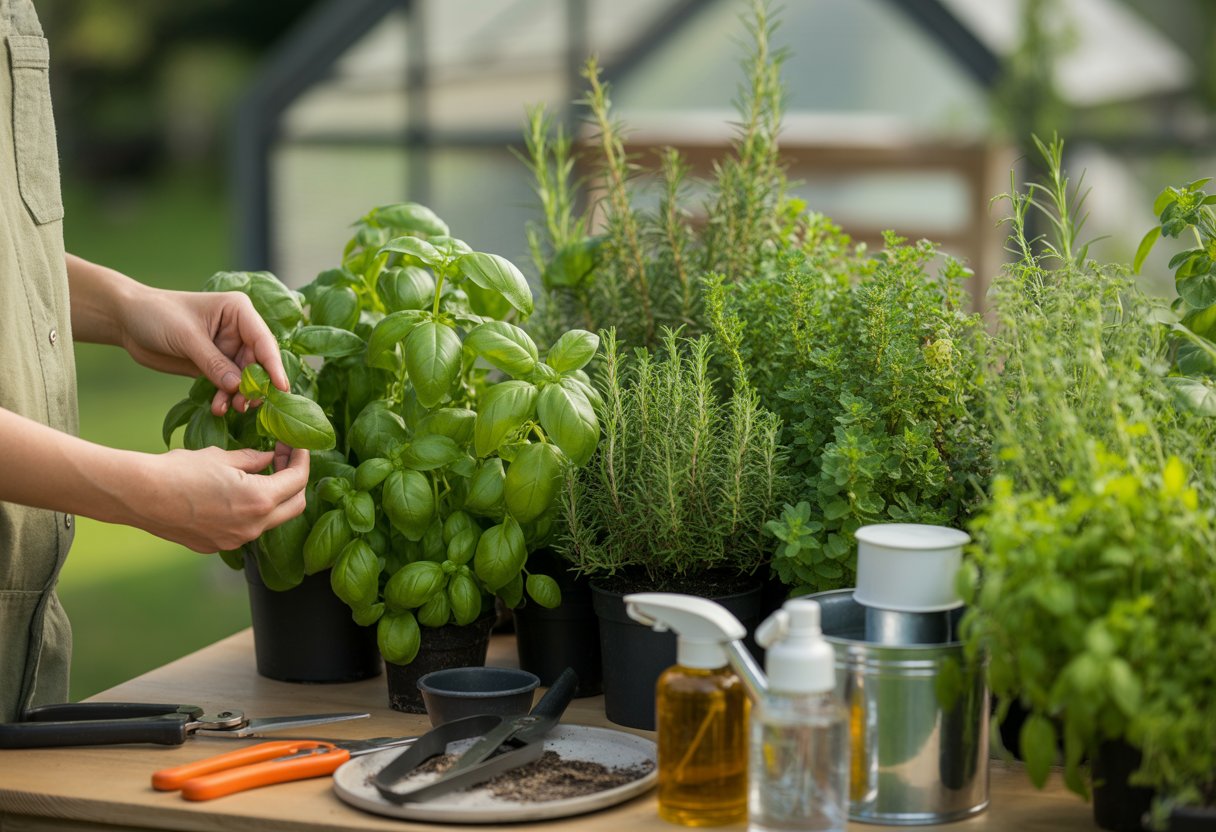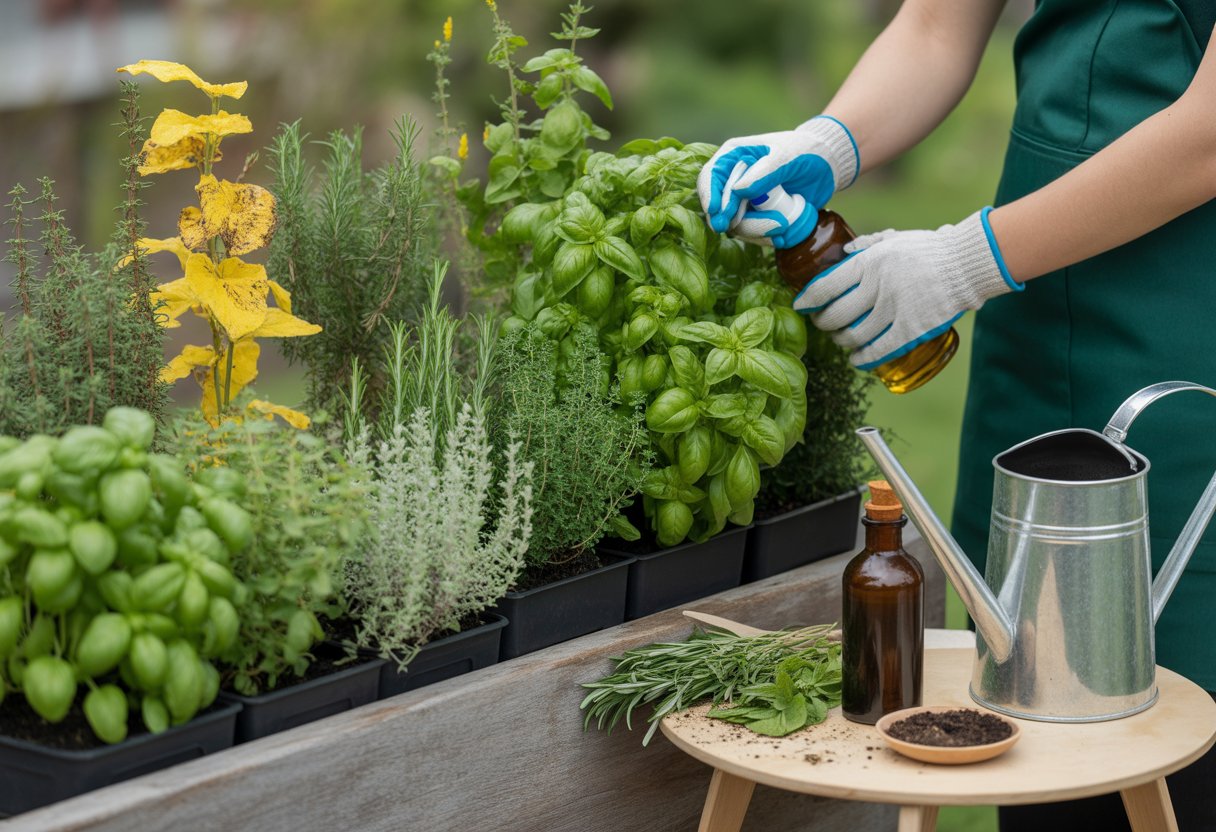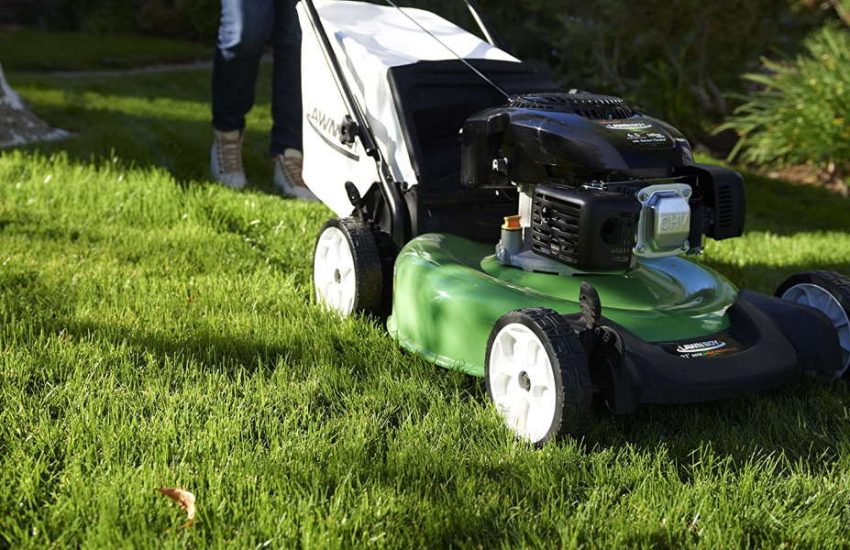Common Problems with Herb and Solutions for Effective Growth and Care
Herb gardening’s rewarding, sure, but it comes with its own set of headaches—pests, bad soil, and watering mishaps, just to name a few. These issues can stunt growth or zap the potency from your medicinal plants if you ignore them.

A lot of folks struggle with getting the balance of sunlight and moisture right, especially for herbs like basil, thyme, and rosemary. Too much or too little water leads to root rot or wilting, and if the sun’s off, plants just don’t bounce back.
Pests—think aphids—and fungal diseases show up more often than you’d like, so you’ve got to keep an eye out and use natural fixes when you can.
Common Growing Challenges for Herbs
Growing herbs well means you’ve got to juggle water, soil, sunlight, and temperature. Each one impacts herb health in its own way.
Improper Watering: Overwatering and Underwatering
Water matters a lot, but getting it wrong causes headaches. Overwatering creates soggy soil and drains poorly, setting up root rot and fungal problems.
Mediterranean herbs like rosemary and thyme really hate wet feet. They want well-drained soil and dry spells between drinks.
If you underwater, soil dries out and plants get stressed—leaves wilt, growth slows. Shallow watering doesn’t cut it; deep, less frequent watering builds stronger roots.
Check soil moisture often. Mulch helps keep moisture in and slows evaporation.
Soil Issues: pH, Nutrients, and Drainage
Most herbs do best in soil that drains well and has balanced nutrients with a moderate pH. Slightly acidic to neutral (pH 6.0-7.0) usually works.
If soil’s too acidic or alkaline, plants can’t grab the nutrients they need—leaves turn yellow or look weak. Bad drainage means soggy roots and trouble.
Mixing in compost boosts soil structure, nutrients, and drainage. Test your soil before planting so you know what to fix.
Light Requirements: Full Sun vs. Partial Shade
Sunlight needs change between herbs. Basil, rosemary, and sage want full sun—at least six hours a day—to really shine.
Perennials usually like full sun, but some annuals handle a bit of shade. Not enough light, though, and you’ll get leggy, weak plants.
Partial shade’s fine for herbs that don’t love harsh afternoon sun, but you might sacrifice some flavor or aroma. It’s worth scoping out your planting spot’s sunlight before choosing herbs.
Temperature and Climate Stresses
Herbs all react differently to temperature swings. Mediterranean herbs shrug off heat but hate cold or frost.
Annual herbs need warmth and can die off if it gets too chilly. When it’s hot, herbs need more water and dry out faster.
Sudden cold snaps can shock herbs and slow them down. Row covers or moving potted herbs inside helps dodge weather stress.
It pays to know each herb’s climate sweet spot before planting.
Herb Diseases and Pest Management
Herbs run into a bunch of trouble from diseases and pests. Spotting issues early, treating them, and taking steps to prevent them keeps plants happy.
Common Diseases Affecting Herbs
Fungal diseases like root rot and wilting hit herbs hard when drainage’s bad or you overwater. Mushy, black roots and droopy leaves usually mean root rot’s set in.
Wilting can also come from soil pathogens or missing nutrients. Powdery mildew and leaf spot diseases show up as white powder or dark spots on leaves, making it tough for plants to photosynthesize.
Letting leaves dry and giving plants room to breathe helps. Mix in organic matter and use organic fertilizers to build up resistance.
Cut off infected parts right away so problems don’t spread.
Pests: Identification and Solutions
Herbs attract pests like aphids, slugs, and whiteflies. Aphids cluster on new shoots and cause leaves to curl or yellow. Slugs chew holes and leave slime everywhere.
Handpick slugs and use crushed eggshells as barriers. For aphids, try insecticidal soap or bring in beneficial insects like ladybugs.
Check herbs regularly for pests. Healthy, well-fed plants bounce back better.
Preventive Care and Organic Solutions
Stay ahead by watching for disease or pest signs. Mulch helps even out soil moisture and temperature.
Don’t crowd plants—good spacing keeps air moving and cuts down on fungus. Use organic fertilizers for steady growth and defense.
Skip the overwatering; it just invites root rot. These organic moves keep herbs thriving without chemicals.
Optimizing Growth and Maintenance

Strong herbs need the right nutrition, timely pruning, and smart plant choices. Keeping up with maintenance and knowing plant cycles makes a big difference.
Nutrient Deficiencies and Fertilization
Herbs often fall short on nitrogen, phosphorus, or potassium. Nitrogen helps leaves grow, phosphorus boosts roots and flowers, and potassium keeps plants sturdy.
If leaves yellow or growth stalls, you’re probably missing something. Use a balanced fertilizer or go organic with compost or fish emulsion.
Feed herbs every 4-6 weeks while they’re growing. Test your soil so you’re not guessing.
Add only what’s needed—too much fertilizer can dull flavor and stress plants.
Pruning, Flowering, and Harvesting Best Practices
Snipping herbs back encourages bushy growth. Cut off flower buds early so the plant puts energy into leaves.
Once herbs start to flower, flavor drops. Pinch flowers or cut stems above a leaf node to keep the harvest going.
Pick herbs in the morning for the best flavor. Use sharp scissors or pruners to avoid tearing stems.
Never take more than a third of the plant at once—it’s easy to overdo it.
Herb Selection: Annuals, Perennials, and Raised Beds
Choosing annual or perennial herbs changes how you plan. Annuals like basil finish up in a season and need replanting.
Perennials—think rosemary or thyme—come back year after year but might need trimming to stay productive. Raised beds are a game changer for drainage and soil control.
You get to tweak soil pH and organic matter, which is great for fussy herbs. Pick herbs that fit your climate and soil so you’re not fighting nature.
Specific Herb Problems and Solutions

Some herbs just have quirks—they need special care for pests, soil, or harvesting. Targeted fixes usually do the trick.
Lavender, Rosemary, and Garlic Troubles
Lavender loves sandy, well-drained soil. If you overwater, root rot sneaks in fast, so drainage is key.
Skip overhead watering and prune it often to dodge fungus. Rosemary’s similar but hates the cold even more.
Powdery mildew bugs rosemary, but neem oil or more airflow helps. Garlic gets hit by white rot and nematodes.
Rotate crops and pick resistant varieties to avoid those. Plant garlic in loose, not-too-wet soil—bulb rot is a real pain.
Coriander, Chives, and Dill Growth Issues
Coriander bolts in the heat, so give it some shade and pick leaves often to slow it down. It can get leaf spot, so yank out infected leaves fast.
Chives are tough but can get rust fungus—look for orange spots. Remove bad leaves and try sulfur-based sprays.
Split chives every so often to keep them strong. Dill needs full sun and good drainage; too much water spells root rot.
Aphids love dill, but insecticidal soap or ladybugs take care of them. Dill grows quick, so harvest often for more leaves.
Chamomile, Echinacea, and Fennel Specifics
Chamomile likes sandy, draining soil but gets powdery mildew if it’s too damp. Space plants out for airflow and pick flowers before they open fully for the best oils.
Echinacea can catch aster yellows—leaves get weird and flowers suffer. Pull sick plants to keep it from spreading.
Full sun and well-drained soil keep echinacea happy. Fennel can take over if you let it and draws aphids and caterpillars.
Prune often and use organic sprays if pests show up. Harvest fennel seeds late in the season—they’re what make the herb unique.
Ginseng, Hypericum Perforatum, and Tansy Case Studies
Ginseng likes shaded, well-drained soil with plenty of organic matter. The roots are prone to rot, and the leaves can get blight pretty easily.
It grows slowly, so patience is a must. Mulching helps protect those roots when winter rolls around.
You’ve got to identify the plant correctly—nobody wants to risk accidentally harvesting wild ginseng and breaking the law.
Hypericum perforatum (St. John’s Wort) prefers sunny spots, but too much watering will turn its leaves yellow. Rust and leaf spot can show up, but you can manage them by using fungicides or just snipping off the bad parts.
This herb’s pretty popular in natural remedies, mostly because of its alkaloids.
Tansy tends to grow like it owns the place and will crowd out other herbs if you let it. Aphids love it, but tansy shrugs off most diseases.
It’s got toxic alkaloids, so you need to be careful—identifying it right is important. People often plant tansy alongside other crops since it keeps pests at bay in a more natural way.


